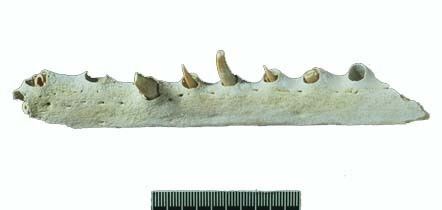Phylum Chordata Order Crocodiles | Class Reptilia Rank Genus | |
 | ||
Similar Harpacochampsa, Kentisuchus, Gryposuchus, Thecachampsa | ||
Ikanogavialis is an extinct genus of gryposuchine gavialoid crocodilian. Fossils have been found from the Urumaco Formation of Venezuela. The strata from which remains are found are late Miocene in age, rather than Pliocene as was once thought. A possible member of this genus survived into the Late Holocene in the Solomon Islands.
Contents
Description
Ikanogavialis had a dorsoventrally deep snout and a distinctive notch between the dentary and maxillary alveoli. The external nares projected anterodorsally from the rostrum. This can be seen as a plesiomorphic characteristic in crocodilians, but given that the earliest gavialoids possessed dorsally projecting external nares, this feature can be seen as having been a reversal from the gavialoid apomorphy back to the crocodilian plesiomorphy rather than having been directly obtained from an early crocodilian ancestor.
Species
The type species of Ikanogavialis is I. gameroi. It was named in 1970 from material found from the Urumaco Formation. A Pleistocene gavialoid named Gavialis papuensis from Murua, part of the Solomon Islands, bears some vague similarities with Ikanogavialis and was referred to the genus in 1999, along with other slender-snouted forms from the Neogene of South America and Africa.
Paleobiology
Ikanogavialis may have lived in a coastal paleoenvironment along with other gavialids such as Gryposuchus. The strata of the Urumaco Formation were deposited in both marine and fluvial settings, although it is unclear to which portion both genera belong. Other gavialoids such as Siquisiquesuchus and Piscogavialis are known to have lived in coastal environments, and it is likely that extant freshwater gavialoids such as Gavialis may have originated from these coastal forms. Ikanogavialis also existed with many other crocodilians in Venezuela during the late Miocene including the giant caiman Purussaurus and an extinct species of Melanosuchus.
"Gavialis"/Ikanogavialis papuensis was similarly fully marine, having been found in association with sea turtles and sirenians. It represents the youngest fully marine crocodillian to date.
